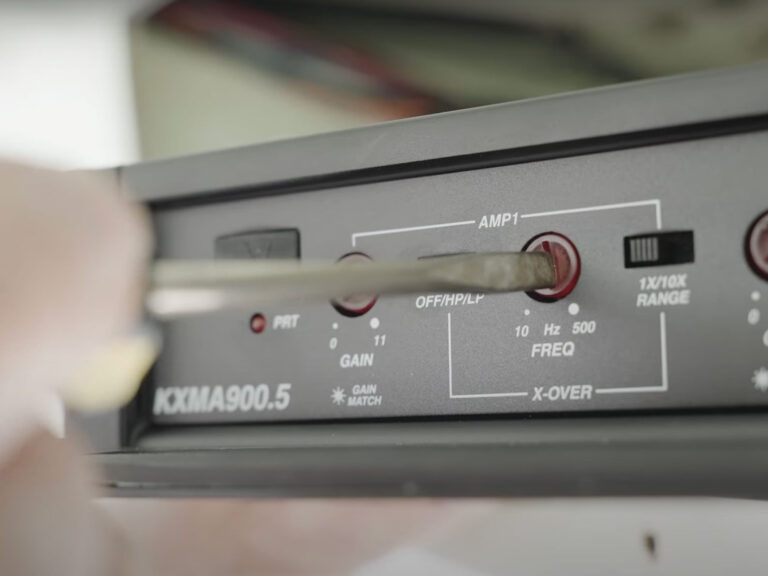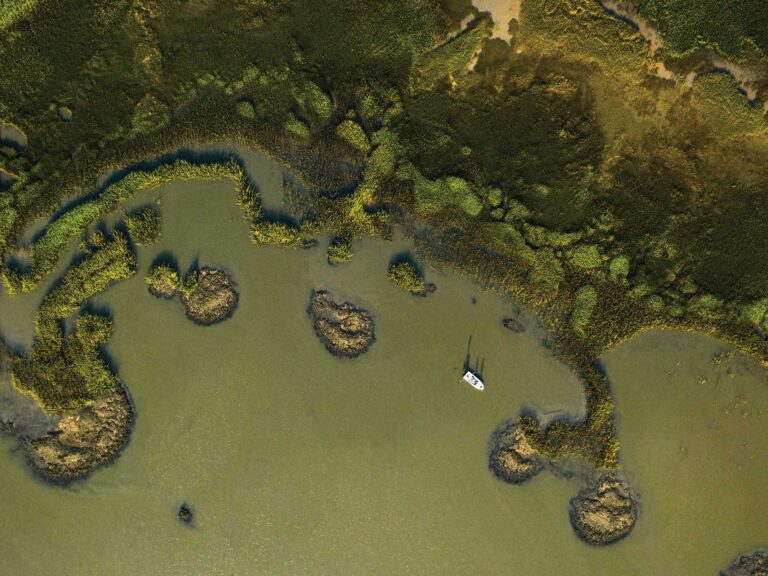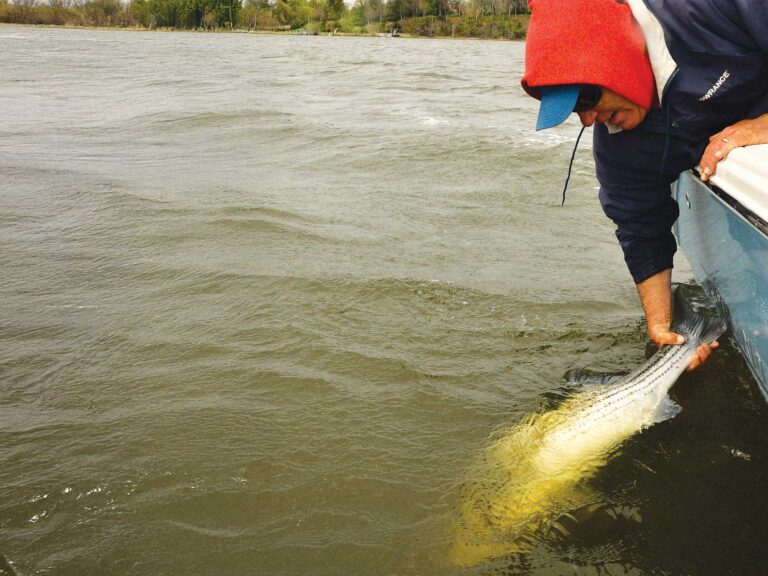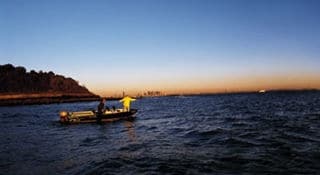
| The morning sun illuminates the Boston skyline as SWS Associate Editor Jason Wood casts for striped bass in the waters off Long Island. |
Codfish. I was catching codfish in Boston Harbor. Something was wrong with this picture, but then again, it was perfectly right. After all, what could be more appropriate than catching the cod in Boston, the city that cod built? Appropriate, but hard to fathom. If you told the average Bostonian that he could catch keeper-sized cod – edible, non-mutant cod – in the shadow of the downtown skyline, he might think you had spent too much time in Boston Harbor. Having been born and raised in Boston, I felt the same sort of disbelief when Pete Santini, the proprietor of Fishin’ Finatics tackle shop in Everett, called to invite me on an early-May cod trip with Captain Lou Abate. Cod in the harbor? I had to see this for myself.
The next morning, Pete and Lou picked me up at Rowes Wharf, just a short walk from the Salt Water Sportsman offices. Ten minutes later we were jigging a rocky ledge just a few hundred yards off Deer Island, site of the huge, egg-like tanks of the waste-treatment facility that processes the effluvia generated by the human population of greater Boston. Granted, it wasn’t the most serene setting in the world, with giant tankers threatening to run us down and commercial airliners roaring just overhead into nearby Logan airport, but the enormous Deer Island treatment plant was one reason we were enjoying codfish action in the harbor.
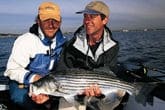
Harbor guide Phil Klug displays a schoolie bass taken by Matt Koenig during a fall blitz off Winthrop.|
The water was even cleaner now than it was when Santini, Abate and I had fished the harbor for stripers in the summer of 2000. “It keeps getting cleaner every year,” Santini had told me then as we trolled a tube-and-worm combo in front of the airport. “Ten years ago it was just dirt.” Abate had nodded in agreement, adding that the water visibility next to his dock slip at the Constitution Marina in Charlestown improves by about one foot every year. I found that remarkable (I still do), but no more so than the fact that we were plucking striper after striper from a harbor that was, until quite recently, considered one of the most polluted bodies of water on earth.
Stripers in the City
Striped bass are perhaps the biggest success story in Boston Harbor, and serve as the bread-and-butter of charter captains such as Lou Abate. The action typically starts in mid-May, shortly after the arrival of herring, which enter the Charles River to spawn far upstream. The stripers follow the herring deep into the harbor, eventually stacking up below the dam at the Museum of Science. Once the fish arrive, a cadre of savvy anglers emerges from the city woodwork and gathers at the Charles River locks in what has to be one of the most bizarre urban-fishing phenomena in the U.S. As cars and trucks whiz by on the expressway above, the fishermen free-line live herring from the catwalk that runs along the top of the dam, often scoring with large fish that have to be landed with the aid of long-handled nets or gaffs.

Bluefish can be caught on all manner of plugs in and around Boston Harbor from June through September.|
You can also find stripers chasing herring in the channel leading into the inner harbor. The action usually takes place from Castle Island to the new federal courthouse and along the edge of Governor’s Flats in front of Logan airport. If you see working birds, get there fast, because it usually means that stripers are busting herring on the surface. This exciting scenario is most likely to happen from first light to about 7:00 a.m., before the sun and increasing boat traffic put the schools down. If the fish aren’t showing on top, use your depthsounder to locate the herring schools or the bass themselves. You can use a Sabiki rig to jig up some herring for live-lining, or try trolling a swimming plug or parachute jig on wire or leadcore line to reach the fish.
Herring action usually lasts until early June, when the stripers start to settle into their summer haunts. Any angler who has ever flown into Boston will no doubt have noticed the abundance of prime structure in and around the harbor. The network of uninhabited islands (now part of a National Park), ledges, flats and deep channels are made to order for stripers, and keeper-sized fish can be taken all season long.
Schoolies are abundant, too, often providing incredible light-tackle fishing on fly, plug and spinning gear. In past years, anglers could enjoy non-stop surface action off Thompson and Spectacle Islands every morning by simply looking for masses of birds working over huge schools of feeding fish. It was common to catch one schoolie after another on flies, spoons, plugs, jigs and soft-plastic baits from dawn until about 9:00 a.m.
Tubes & Chunks
For bigger bass, the best plan is to go deep. Abate and Santini like to troll long tube lures (always rigged with a seaworm on the hook) on leadcore line in depths ranging from ten to 20 feet. One of the best spots to troll the “tube-and-worm” is the area of shallow water called the Lower Middle, between the C5 and C1 cans. There are lots of boulders here, so use caution, especially at low tide. Another great area to troll tubes is along the edges of Great Faun Bar, a rocky ledge that extends east from Deer Island and is exposed at low tide.
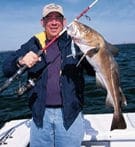
Capt. Lou Abate of Good Times Charters displays proof that healthy, keeper-sized cod can once again be taken inside the harbor.|
According to Abate, the key to fishing a tube is to keep it swimming as close to the bottom as possible. If you feel a tap, don’t try to set the hook; otherwise you may pull the tube away from the fish. Instead, lower the rod slightly to feed the worm back and let the striper “climb on” before raising the rod slowly to fight the fish.
While the two aforementioned spots are perennial producers of bass, there are literally hundreds of places to troll wire or leadcore line in Boston Harbor. Basically, any stretch of rocky bottom or drop-off in the eight- to 20-foot depth range is a good place to troll tubes, jigs and swimming plugs. Just be sure to swim the lure close to the bottom and keep your trolling speed under five knots.
Chunking is another popular striper and bluefish technique in the Boston area, and produces well throughout the season. It’s especially productive in midsummer, when the biggest fish tend to sulk in deep water during the day. Good chunking spots include the undulating bottom off Point Allerton at the northern end of Nantasket Beach, as well as the humps in the area known as Bob’s Bass Triangle, which lies between the North and South Channels. The Roaring Bulls, located halfway between Green Island and the group of outer islands known as the Graves, as well as the backside of Georges Island, also produce bass on chunks.
Casting Around the Rocks
If you prefer to cast for your fish, there are numerous places to try, but always remember that you’ll do best at dawn and dusk. Any stretch of rocky shoreline or underwater ledge is worth a shot, but expect the fish to hold in deeper, cooler water as the season progresses.
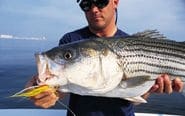
The numerous islands and ledges of Boston Harbor provide world-class fly fishing for striped bass throughout the season. Best bet is to fish early or late in the day, and to use a fast-sink line to get the fly down to where the fish are holding.|
Perhaps the best casting spots in midsummer are the outer islands in Massachusetts Bay, such as the Graves, the Brewsters, Calf Island and Green Island. If you’re a fly caster, fish a fast-sink or shooting-head line around rocky island shorelines, especially those fronting the open ocean. Big Clousers, Deceivers, Snake flies, and mackerel and herring imitations are tops, and be sure to work them slowly. Harbor fly guide Fred Christian often finds big fish around the islands and ledges exposed to ocean swells. He instructs his anglers to cast the fly as close to the rocks as possible and let it settle in the turbulent water before beginning the retrieve. The same technique can be applied to soft-plastic baits and jigs.
Fall often brings sensational surface action, as migrating schools of stripers and bluefish sweep through the harbor and surrounding areas. I experienced this fall feeding frenzy first-hand while fishing with guide Phil Klug, who heads up the fishing department at Stoddard’s in downtown Boston. On a late-September day, Phil, Matt Koenig and I found massive clouds of birds working over acres of busting schoolies on the edge of the North Channel off Deer Island. As the tide rose, the fish pushed the bait into the shallows along Winthrop Beach, and we hooked up on nearly every cast for well over an hour. A week or so later we made another trip, and this time found the stripers – mixed with a few bluefish – popping up all the way from Revere to Quincy Bay.
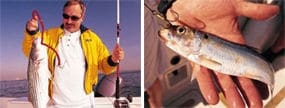
Trolling a tube-and-worm combo (above left) on leadcore line or live-lining a herring (above right) around the rocks and channels are two deadly techniques for taking Beantown stripers.|
Speaking of bluefish, this species can be taken in and around Beantown from June through September. While you’re likely to find them in the same places as stripers, one of the most reliable spots for big blues throughout the season is the area around the B Buoy, some four miles due east of the Graves. This is deep water – 90 to 100 feet – and the method of choice is trolling large swimming plugs on wire line or downriggers. The best depth varies, so it’s a good idea to fish several lines at different levels of the water column until you find the payoff zone.
Flounder Fest
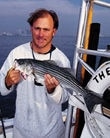
On some days, Boston anglers can catch all the stripers they want on flies, jigs, spoons and soft-plastics during huge surface blitzes that last for hours at a time.|
Anglers looking for a few fresh-fish dinners to take home will be pleased to hear that winter flounder are coming back strong in the Boston area. Pete Santini reports excellent fishing in 15 to 20 feet of water off Faun Bar (between the 6 and 6A buoys) beginning in mid-May and running through mid-August. Another good flounder spot is the mud-and-rock bottom in 28 feet of water off Green Island, as well as Hospital Shoal off Georges Island. Additionally, increasing numbers of blackbacks are invading their former shallow-water haunts in Dorchester and Quincy Bays; Hull Gut and Blacks Creek have been productive. According to Santini, the key to catching flounder is to anchor up and send down a chum pot filled with Double Strike Chum. If the fish don’t arrive in 15 to 20 minutes, try another spot.
Talk of bottom fishing naturally brings us back to the subject of Boston’s comeback cod. Late last October, Santini and Lou Abate witnessed outstanding cod action between Deer Island and Spectacle Island, sparked by a mass exodus of juvenile herring from the local rivers. Another good area to target cod is the No. 5 can off the Graves. The wrecks and hard bottom just outside the harbor, particularly the area a mile east of the B Buoy, can also hold groundfish, but the action can be hit-or-miss depending on how much fishing pressure these spots have received in recent weeks.
Still, even slow action with cod is better than no action at all, and the fact that these fish can once again be caught on Boston’s much-maligned doorstep is reason enough for celebration. At the very least, it should offer encouragement that even the most abused ecosystem can recover if given the chance. Who knows? In time we might be able to catch cod throughout the harbor, as they did back in the 1700s. Given the recent successes, anything seems possible.
| ## Boston Harbor Charters, Guides and Fishing Info | ||
| ### Charter CaptainsCapt. Lou Abate, Good Times Charters, (781) 284-6282; www.bostoncharters.com Capt. Phil Klug (fly & light tackle), (781) 306-0277 Capt. Fred Christian (fly & light tackle), (978) 745-5339; www.captainfred.com Capt. Ernie Sordillo, (617) 846-7986 Capt. John Pirie (fly & light tackle), (978) 468-1314; www.olfc.com Capt. Wayne Frieden (fly & light tackle), (781) 545-6263 Capt. Tom Koerber (fly & light tackle), (617) 965-4833; www.roccuscharters.com Capt. Paul Diggins, (617) 922-FISH; www.bostonfishing.com Capt. Roger Brousseau, (781) 335-3298; www.fishboston.com Capt. Mike Bartlett (fly fishing), (781) 293-6402 Capt. Joe D’Orsi, (781) 284-9498 Capt. Jimmy Brennan, (781) 395-2466 Capt. Chuck DeStefano, (781) 461-8706### Area Tackle ShopsFishin’ Finatics (Everett), (617) 381-1997; www.fishfinatic.com Stoddard’s (Boston), (617) 426-4187 Orvis (Boston), (617) 742-0288 Firefly Outfitters (Boston), (617) 423-3474 Bob Smith’s (Boston), (617) 426-4440 Dolphin Bait & Tackle (E. Boston), (617) 568-9200 Roach’s Sporting Goods (Cambridge), (617) 876-5816 Neponset Circle Fish & Dart (Dorchester), (617) 436-9231 Arlington Bait & Tackle (Arlington), (781) 646-5598 Fore River Fishing Tackle (Quincy), (617) 770-1397### Charts & BooksFor an excellent laminated chart of Boston Harbor and vicinity, complete with highlighted fishing hot spots and the GPS coordinates of productive wrecks, look for Capt. Segull’s Sportfishing Chart #BH102 in a tackle shop, or call (888) 473-4855.To order a copy of The Flyfisherman’s Guide to Boston Harbor, Jack Gartside’s detailed book on fly fishing the harbor, call (617) 277-5831 or visit www.jackgartside.com. |






